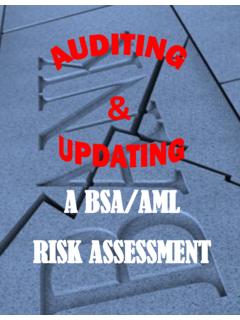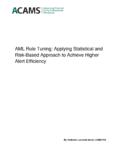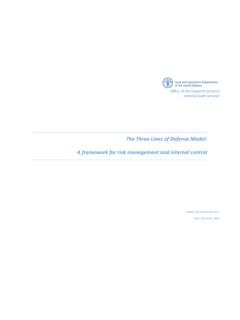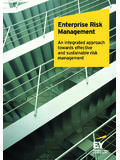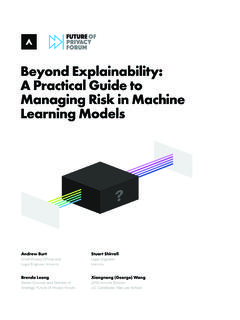Transcription of Bank Secrecy Act Auditing for Community Banks: A …
1 bank Secrecy Act Auditing for Community Banks: A. Risk-Based Approach Susan Cannon, CAMS-Audit, CRCM. Table of Contents Executive Summary .. 3. One Size Does Not Fit All .. 3. Defining a Community 3. Defining Risk-Based Audits and Testing .. 4. Designing Risk-Based Audits and Sampling Strategies .. 6. Planning and Scoping Laying the Ground Work for a Risk-Based 6. Audit Program Development .. 9. Risk-Based Sample Selections .. 12. 13. References .. 15. Executive Summary Federally-insured depository institutions in the are required by regulationi to implement written bank Secrecy Act/anti-money laundering (BSA/AML) compliance programs. These programs must be approved by the board of directors and at a minimum, are required to: Provide for a system of internal controls to assure ongoing compliance;. Provide for independent testing of BSA/AML compliance.
2 Designate an individual or individuals responsible for coordinating and monitoring day- to-day compliance; and Provide training for appropriate personnel These required program components are typically referred to as the four pillars of a BSA/AML. compliance program. This white paper will discuss some specific strategies for achieving compliance with the independent testing pillar for smaller banks, often referred to as Community banks, . commensurate with their BSA/AML risk profiles. Specifically, I will discuss customizing the independent testing approach and accompanying audit program so that it is appropriately risk- based. Additionally, strategies for selecting risk-based transaction testing samples will be discussed. It is important to note that appropriate scoping, planning, audit programs and sampling techniques are but a few of the overall considerations in successful BSA/AML Auditing .
3 Other resources should be consulted with respect to auditor independence, managing the audit, documenting work, formulating conclusions, issuing final reports and tracking and validating clearance of exceptions. Suggestions outlined in this paper are based on my own experiences and methodologies in conducting BSA/AML audits for Community banks over the past 15 years, along with additional insights and tips I have learned from interviewing colleagues and regulators. One Size Does Not Fit All Defining a Community bank Prudential regulatory agencies in the use asset size to determine examination strategy. For example, the Office of the Comptroller of the Currency (OCC) defines Community banks as banks with less than $1 billion in total assets. A national bank or federally chartered thift's asset size determines whether an institution will be examined using the Community bank Supervision Process or the Large bank Supervision The Federal Deposit Insurance Corporation's (FDIC) Community Banking Studyiii acknowledges that the standard method for defining Community banks is based on asset size; however, this benchmark on a stand-along basis can be arbitrary.
4 The study states that while banks with $1 billion or more in total assets Page 3 of 16. are typically defined as large banks, that fixed dollar limit does not take into account inflation, economic growth and the size of the banking industry itself. Therefore, a bank crossing the $1. billion total assets threshold may still exhibit the characteristics of a Community bank such as a continued focus on providing traditional banking services to a smaller more localized market. Quarterly, the FDIC publishes aggregate data for all FDIC-insured According to the Ratios by Asset Size data, published for March 31, 2014, roughly 90 percent of the total number of FDIC-insured depository institutions have total assets under $1 billion. Percentage of Total Number of Number of Institutions Institutions Asset Size Group Reporting Reporting Assets > $10 Billion 107 Assets $1 Billion - $10 Billion 565 Assets $100 Million - $1 Billion 4,053 Assets < $100 Million 2,005 All Insured Institutions 6,730 Regardless of a bank 's asset size, as part of its core assessment procedures, the OCC's Community bank and Large bank supervisory frameworks refer examiners to the Core Examination Overview Procedures section of the Federal Financial Institutions Examination Council (FFIEC) BSA/AML Examination Manual.
5 V Both frameworks call for completion of appropriate expanded procedures in the FFIEC BSA/AML Examination manual when specialized activities or specific products warranting additional review are present. Similarly, the FDIC and the Board of Governors of the Federal Reserve System utilize the core and, when appropriate, expanded procedures of the FFIEC BSA/AML Examination Manual as part of the supervisory process for banks of all sizes. Although all banks in the are examined using the same set of BSA/AML examination procedures, the scope, depth and frequency of independent testing increases with the size and complexity of the bank . At one end of the spectrum, Community banks usually have BSA/AML. audits once every 12 to 18 months compared to more rigorous continuous BSA/AML audit processes implemented by large audit teams in place at the nation's largest banks.
6 It is not feasible and would be cost prohibitive for a typical small Community bank to apply the same independent testing strategies and techniques designed for a large, complex bank . To attempt to do so would not be a risk-based approach. The independent testing function must be adjusted to an appropriate scale. Defining Risk-Based Audits and Testing A BSA/AML compliance program should have three lines of defense. vi Page 4 of 16. 1. The first line of defense is to appropriately identify risks and implement policies and procedures to mitigate those risks for lines of business and customer-facing personnel. 2. The BSA/AML officer oversees the second line of defense through ongoing oversight and monitoring of the program to assure compliance. 3. Internal audit serves as the third line of defense by conducting independent evaluations of the adequacy of the overall program including policies, training, internal controls and compliance oversight.
7 Management should assure that independent testing scope, methodology and frequency of reviews are appropriate for the bank 's risk profile. The BSA/AML Compliance Program Overview section of the FFIEC BSA/AML Examination Manual provides a discussion of regulatory expectations with respect to the Independent Testing pillar. The audit should be risk based and evaluate the quality of risk management for all banking operations, departments, and subsidiaries. Risk-based audit programs will vary depending on the bank 's size, complexity, scope of activities, risk profile, quality of control functions, geographic diversity, and use of technology. An effective risk-based Auditing program will cover all of the bank 's activities. The frequency and depth of each activity's audit will vary according to the activity's risk assessment.. The guidance further outlines minimum standards for independent testing.
8 Included in those standards are conducting appropriate risk-based transaction testing to verify the bank 's adherence to the BSA record keeping and reporting requirements ( , CIP, SARs, CTRs and CTR. exemptions, and information sharing requests). The Certified Anti-Money Laundering study guidevii published by the Association of Certified Anti-Money Laundering Specialists (ACAMS). similarly provides guidance regarding what independent testing should entail. The guidance includes the following: Perform appropriate transaction testing, with particular emphasis on high-risk operations (products, services, customers and geographic locations).. Increasingly, enforcement actions and Matters Requiring Attention (MRAs) in examination reports have cited weakness in independent testing. Failing to have a risk-based audit plan that focuses on high-risk areas and insufficient transaction testing are among the most common regulatory criticisms of AML independent testing In his 2013 white paper, Kenneth Simmons provided a unique analysis compiling the results of MRAs for OCC regulated banks.
9 Ix The analysis covered reports with BSA-related MRAs issued from September 2009 through March 2013 issued for 137 financial institutions. Of the 32 active MRAs identified in the paper related to significant BSA/AML audit deficiencies, 25 (78 percent). involved banks with total assets less than $1 billion. Simmons states in his paper that although audit staff may not recognize deficiencies from time to time, following effective risk-based Auditing limits these occurrences. Page 5 of 16. Designing Risk-Based Audits and Sampling Strategies Planning and Scoping Laying the Ground Work for a Risk-Based Review Yogi Berra said If you don't know where you are going, you'll end up someplace else. x In BSA/AML independent testing, you need to know where you are going by understanding the bank 's unique risks . Doing so will enable you to map out an appropriate plan so that you end up providing relevant findings and recommendations.
10 Independent reviews may be performed by an employee of the bank , provided he or she is sufficiently independent of the process and possesses the requisite knowledge and skills to perform the review. Alternatively, many banks outsource independent reviews to third-party service providers. Regardless of who is performing the review, initial interviews need to be held with management to determine the bank 's overall risk profile so that the audit can be appropriately scoped and budgeted in line with the bank 's unique characteristics. Typically, third-party vendors also use this information to develop a proposal of the overall scope and pricing for the engagement. The stated scope should be consistent with regulatory expectations. It should also specify what is and what is not included in the review. Specific high-risk activities such as parallel banking, pouch activities and foreign correspondent banking, to name a few, often do not apply to Community banks.

